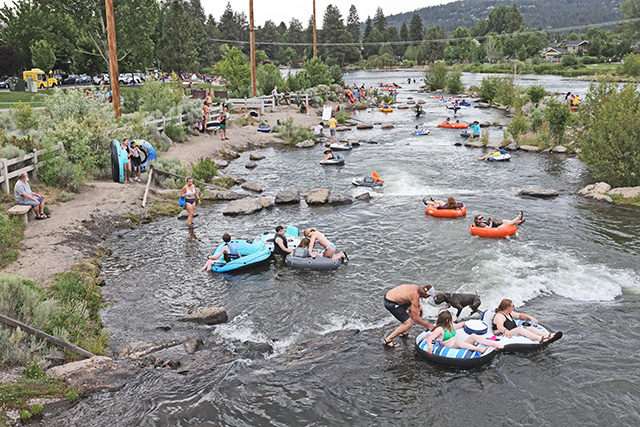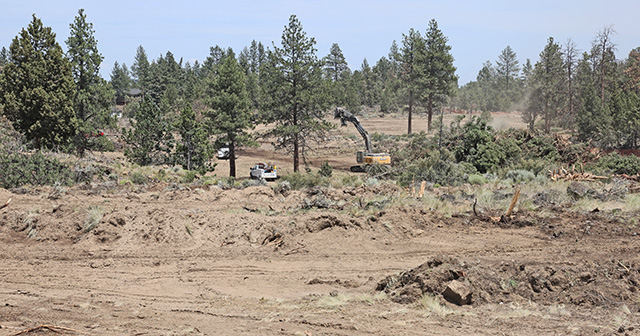Shipwrecks of the Oregon Coast
Published 12:00 am Sunday, September 20, 2015

- Barb Gonzalez/ For The BulletinThe shell of the Peter Iredale has been mired in the sands of Fort Stevens State Park, west of Astoria, since it ran ashore in 1906. Winds, waves and fog drove the four-masted barque into Clatsop Spit, about 4 miles south of the Columbia River mouth.
ASTORIA — The rusted steel frame rises ghostlike through the fog of an early September morning, ocean mists curling around the decaying bow of the old sailing vessel, half-buried in Pacific sands.
The Peter Iredale ran ashore on Oct. 25, 1906, a few miles south of the Columbia River bar, and it hasn’t moved since. It has become an unusual tourist attraction at Fort Stevens State Park west of Astoria, where visitors gawk at the wreckage, step across the girders, photograph one another in the ruins and build giant sand dragons to delight their children.
The wreck of the Peter Iredale was not an isolated event. According to the Columbia River Maritime Museum in Astoria, approximately 2,000 vessels, including more than 200 large ships, have sunk at the Columbia River bar since Captain Robert Gray first sailed into the river in 1792. More than 700 people have died in these shipwrecks, helping to earn this stretch of sea the nickname, “Graveyard of the Pacific.”
“Mariners agree that the combination of high seas, a mighty river, and shallow, shifting sand bars make the Columbia River bar one of the most dangerous bar crossings in the world,” reads an interpretive sign at the entrance to the museum. Beside it is a chart that locates the sites and describes the circumstances of 50 of those disasters.
The north coast isn’t the state’s only watery graveyard. Oregon’s string of 19th-century lighthouses weren’t built merely for show. From Tillamook Rock to Cape Blanco, the eight historic structures (Cape Arago was added in 1934) were erected on rocks, reefs and headlands to deter maritime traffic with their piercing lights and foghorns.
Maritime mishaps
Even with those and other precautions, tragedies were inevitable. The Maritime Museum, whose exhibits range across history and economics, is particularly strong in its treatment of two local institutions — the U.S. Coast Guard and the Columbia River Bar Pilots.
From its Astoria-Warrenton bases, the Coast Guard patrols 420 miles of Oregon and Washington coastline, and hundreds more miles of inland rivers, by sea and air. The importance of the Guardsmen in responding to distress calls is emphasized by a stunning display depicting a high-seas rescue under extreme life-threatening conditions.
The bar pilots began serving the shipping industry in 1846, and they have been treated with reverence in Astoria ever since.
About 10 times a day, every day of the year, these highly trained individuals navigate visiting vessels — tugboats, tankers and container ships — over the bar and through the Columbia’s changing channels. The economic transport of 40 million tons of cargo, valued at $23 billion annually, depending upon them.
It’s probably not mere coincidence that the bar pilots assumed their role in the same year that the USS Shark was destroyed on the Columbia River Bar. The 86-foot U.S. Navy schooner had arrived in July 1846 to survey the river’s mouth and evaluate political tensions between the United States and England in the disputed Oregon Territory. Two months later, as it attempted to cross the bar after completing its mission, the Shark was torn apart as heavy North Pacific winds collided with the strong currents of the Columbia. The entire crew of 70 clung to the wreckage and miraculously survived.
The story of the USS Shark might have been forgotten, like so many other shipwrecks, had not a section of the deck been washed out to sea. One of its cannons washed ashore at Arch Cape, nearly 40 miles south. When it was rediscovered in 1898, the tiny nearby community of Elk Creek was renamed Cannon Beach in its honor. But another century passed before the Pacific relinquished more of this unique treasure.
A current exhibit at the Columbia River Maritime Museum displays more than 80 items reclaimed when the Shark was again exposed in 2008 near Arch Cape. After a father and daughter discovered the muzzle of an 18-pound carronade (short-range cannon) protruding from a sandy beach, archaeologists found dozens of other artifacts. Four years of cleaning and treatment of parts that had been compacted in sediment led to today’s display, which describes how this 19th-century weaponry was made and used.
History and mystery
Topics of this nature are exactly what a new exhibit at the Oregon Coast Aquarium addresses. “Secrets of Shipwrecks: Part History, Part Mystery” focuses on locating, exploring, excavating, researching and conserving sunken treasures, most of which do not carry gold doubloons or “pieces of eight.”
The exhibit is largely geared toward an audience of young families, the aquarium’s principal demographic. Visitors enter through a shipwreck facade, where they are encouraged to consider possible reasons the ship went down — was it a boiler room explosion? a collision with an unseen reef? In an adjacent room, a life-size model depicts a diver recovering items from an undersea site using such tools as a water jet, a dredge and an air lift. At an X-ray lightbox in a replica laboratory, future archaeologists may study recovered artifacts for fine details.
Throughout the exhibit area, a variety of marine life may be seen at home in the artificial reef created by shipwrecks. A 6-foot moray eel glares from its den within a sunken cannon. Colorful tangs and ornate butterfly fish dance around a trove of classical pottery, as might be discovered on the floor of the Mediterranean or Red seas.
Adult visitors should not miss a short documentary film, “The Underwater Cultural Heritage,” shown every half hour in a 60-seat theater within the exhibit area. Produced by the United Nations Educational, Scientific and Cultural Organization to highlight its 2001 Convention on the Protection of Underwater Cultural Heritage, the movie is a marvelous educational tool. Together with other measures, it aims at promoting marine archaeology.
“The convention prohibits the plundering of what it identifies as the common heritage of humanity,” intones director-narrator Eric Chebassier. “The waters link civilizations, since they served to carry ships that connected communities around the world. The remains at the bottom of the seas are therefore of particular importance to the world community. Moreover, each wreck is a time capsule providing a dated snapshot of a precise moment of a civilization, a peerless archival record.”
Defining underwater cultural heritage as “all traces of human existence having a cultural, historical or archaeological character which have been partially or totally underwater, periodically or continuously, for at least 100 years,” the film warns that technological advances have made these sites more accessible, but also more vulnerable to looting.
Other wrecks
Unlike the mythical “Goonies” wreck delivered on the big screen by Steven Spielberg and Co. three decades ago, most Oregon coast shipwrecks are far less spectacular. There is a persisting legend that British privateer Sir Francis Drake left a treasure chest buried on the slopes of Neah-kah-nie Mountain, overlooking modern Manzanita, in 1579; but if the fable is indeed true, his ship wasn’t wrecked, instead taking shelter in Nehalem Bay for five weeks of repairs.
A greater treasure, though not of the traditional kind, was beeswax. There were no apiaries in the Americas during the early years of Spanish colonization, so galleons would travel to the Philippines to trade silver and other metals for precious beeswax, which was used mainly in soap and to make candles for Jesuit mission churches.
Around 1700, one such ship was blown off course on a voyage from Manila to Acapulco. When it wrecked on or near the Nehalem spit, its cargo of beeswax (mainly large blocks with Spanish markings), along with shards of Chinese ceramics, were strewn for miles along the coast and washed into river valleys. Well into the 19th century, native residents and pioneer settlers traded these items and used the wreck’s Philippine teak timbers to build furniture.
A prominent shipwreck remains today just upriver from the mouth of the Rogue River at Gold Beach. The Mary D. Hume, a 140-foot steamer, was built of local Port Orford cedar in 1881. Initially delivering fish between Oregon and San Francisco, it later served as a whaling vessel in Alaska and finally as a tugboat. When it was retired in 1977 and returned to Gold Beach, where it became listed on the National Register of Historic Places, it was the longest-serving commercial vessel on the West Coast.
In 1985, as an effort was underway to preserve the Mary D. Hume as a museum ship, she slid into the mud from her berth, the victim of a mechanical accident. No funds were available to raise the vessel, and she has remained ever since as a derelict ship on the shoreline just east of the Jerry’s Rogue Jets boat terminal.
A more recent shipwreck was that of the New Carissa in 1999. The Japanese-owned freighter, en route to pick up a load of wood chips in the harbor at Coos Bay, ran aground as it attempted to ride out a storm. Attempts to refloat it failed, and two of its five fuel tanks began to leak fuel onto the beach, 2½ miles above the bay’s mouth on the North Spit.
This led to significant ecological damage. Even though the U.S. Navy used napalm and plastic explosives to ignite the ship’s fuel (which burned for 33 hours), about 70,000 gallons of fuel oil and diesel leaked into the water. More than 3,000 birds of some 50 species died, although the U.S. Fish and Wildlife Service declared that salvage efforts limited what could have been a much worse disaster.
Still, it took nearly a full decade before the New Carissa was finally put to rest. On Feb. 11, 1999, a week after the incident took place, continued severe weather and structural stress from the fire caused the ship to break in two. An attempt to tow the 440-foot bow to sea failed when the tow line broke. The bow ran aground again 80 miles north, near Waldport, before it was successfully towed out to sea and sunk 280 miles offshore, at a depth of about 10,000 feet.
The stern section remained aground on the beach near Coos Bay for more than nine years, embedded in 20 to 30 feet of sand. It wasn’t removed from the beach until 2008. Even then, some local residents wanted to leave the wreckage on the beach as a tourist draw. In fact, the Coos Bay City Council established a committee to explore marketing options.
Peter Iredale
They might well have been thinking of the Peter Iredale. The four-masted steel barque vessel was sailing from Mexico to Portland, where it was to pick up a shipment of wheat for delivery to the United Kingdom. But it ran aground on Clatsop Spit, about 4 miles south of the Columbia River channel, in thick mist and a rising tide.
High seas and a heavy squall drove the ship to the beach, which it hit so hard that three masts snapped. But there were no casualties: All 27 crew members were rescued by a lifeboat from nearby Port Adams and treated for injuries and exposure at Fort Stevens, then a key American military post at the mouth of the Columbia.
Despite the grounding, the hull of the Peter Iredale suffered little damage. The U.S. Navy made plans to tow the ship back to sea. But severe weather forced a delay in hopes of calmer seas. By the time several weeks had passed, the ship had listed to its port side and become embedded in the sand.
That’s how it remains today — the rusted steel bow, a couple of broken masts and a few ribs defining the original extent of the ship. Storms still capriciously decide how much of the vessel remains visible at any given time.
According to documents from the Oregon Historical Society, Peter Iredale Captain H. Lawrence made this final toast to his ship after his rescue: “May God bless you, and may your bones bleach in these sands.” It seems as appropriate now as it must have been in 1906.
Fort Stevens became an Oregon state park after it was decommissioned in 1947. Today it is administered as a parcel of the Lewis and Clark National and State Historical Parks. Visitors must pay $5 for a parking pass to visit the shipwreck.
— John Gottberg Anderson can be reached at janderson@bendbulletin.com.







